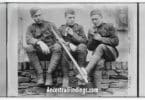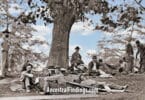You find them in a draft card, a pension file, or a service roster—and then nothing. No census record. No marriage. No obituary. No trace.
Every family historian has run into a veteran ancestor who seems to disappear after the war. These are the quiet mysteries of the family tree. They served their country, came home (maybe), and then vanished. And while they may not have left behind a full paper trail, the clues are often still there… just scattered in places we don’t always think to look.
This is about those veterans—the ones lost to history—and how to find out what may have happened to them after the uniforms were packed away.
Why So Many Veterans Disappeared
There are dozens of reasons why a veteran might seem to vanish from the records after their service:
- They moved far from home, starting over in a place where no one knew them
- They changed their name, due to shame, trauma, legal trouble, or simply to cut ties
- They died young, before many civilian records could be created
- They remained unmarried and childless, leaving no direct descendants to keep their memory alive
- They fell into poverty, illness, or addiction, ending up in almshouses, state hospitals, or veterans’ homes with poor documentation
- They immigrated—or emigrated, vanishing from U.S. records entirely
When this happens, it’s easy to assume the trail is cold. But sometimes, they didn’t disappear… they just stepped into quieter lives.
Military Records May Be the Last Confirmed Sightings
For many of these missing ancestors, the military record is the only time their name appears with certainty. This includes:
- Draft cards
- Enlistment or muster rolls
- Discharge records
- Pension applications (if they lived long enough to file)
- Military hospital admissions
If that’s all you have, use every scrap of detail available—addresses, next of kin, occupation, unit, physical description—to fuel your search.
Sometimes the clues that lead forward are right there in the fine print.
Places to Search When the Trail Goes Cold
Here are some less common (but often revealing) sources to use when your veteran disappears:
State or County Almshouse Records
Many down-on-their-luck veterans ended up in local poorhouses or homes for the indigent. These records sometimes list military service, date of arrival, and notes on health or behavior.
Veterans Homes Admission Files
The National Home for Disabled Volunteer Soldiers kept extensive records—including admissions, discharge, death, and burial. These files often list birthplace, prior residence, next of kin, and physical/mental health history.
Look for them at:
- National Archives (Record Group 15)
- Fold3’s “U.S. National Homes for Disabled Volunteer Soldiers” collection
State Hospital or Asylum Records
War trauma was often misunderstood and poorly treated. Some veterans were institutionalized, sometimes for decades. These records can be hard to access, but indexes or newspaper mentions may point you in the right direction.
Criminal Records and Mug Books
Some veterans got into trouble after returning home. Prison logs, court records, or mugshot books might include service history, even when nothing else does.
Cemetery Records (Not Just National Cemeteries)
Many veterans were buried in unmarked graves or local cemeteries. Church cemeteries, potter’s fields, and obscure burial grounds can hold the key—especially if you find a military symbol or flag holder placed there.
Name Changes, Misspellings, and Identity Shifts
It’s more common than you might think. A veteran comes back and uses a middle name instead of a first. Or adopts a nickname. Or deliberately changes his surname spelling—or ditches it altogether.
When this happens:
- Search every variation of their name—first, middle, initials, nicknames
- Don’t rely on exact birthdates—ages were often approximated
- Search location-based records first: directories, tax rolls, and newspapers
- Use DNA testing—you may find a match with a descendant under a new name
If your ancestor completely changed identity, you may only be able to uncover their story by combining documentary research with genetic clues.
When They Left the Country
Some veterans simply didn’t come back.
- Revolutionary War soldiers moved to Canada or the frontier
- Confederate veterans fled to Mexico, Brazil (Confederados), or British Honduras
- WWI and WWII soldiers sometimes married abroad and stayed
- Disillusioned Vietnam vets relocated to Canada or Southeast Asia
Passenger lists, foreign census records, and alien registration files may help you pick up the trail.
Signs of a Veteran Who Went Missing
Here are some signals to watch for:
- A sudden stop in census listings after the war
- A marriage listed but no death or burial
- A family member referenced in later records (“My uncle John served in the war, but we never heard from him again…”)
- Pension applications filed by siblings or parents, which may give an approximate death date
- Probate records showing the veteran was declared dead or missing
These fragments are pieces of the story—and sometimes, enough to tell you what may have happened.
Honoring the Ones Who Disappeared
Not every veteran left a detailed paper trail. Some didn’t want to be found. Others were lost to time, misfiled records, and forgetfulness.
But their service happened. And their disappearance is part of the legacy, too.
When you research the ones who vanished, you’re doing more than solving a mystery—you’re offering remembrance to someone who quietly slipped through history.
They may have been lost to the record books.
But not to you.






